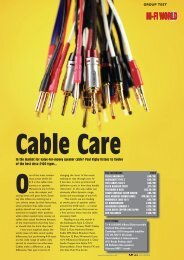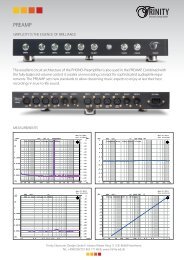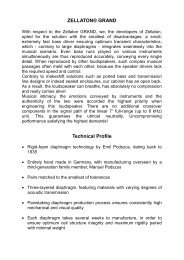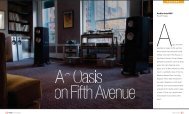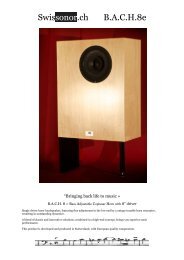Philosophy - Audioarts
Philosophy - Audioarts
Philosophy - Audioarts
Create successful ePaper yourself
Turn your PDF publications into a flip-book with our unique Google optimized e-Paper software.
It started with one frustrated guy…<br />
It all started with one engineer’s frustration on the sound of<br />
CD playback some eight years ago. His name is Junji Kimura, an<br />
eminent engineering designer in Japan. A passionate audiophile<br />
and an established audio engineer, particularly that of LP<br />
playback systems and tube components, Kimura found himself<br />
more and more frustrated with the sound of CD playback<br />
systems. Unlike LP, which offers a rich and fresh musical<br />
presence with ambiance, CD, to Kimura’s ears, sounded too thin<br />
and sharp, too electrical. Despite all the information it<br />
contains, CD was far from providing musical satisfaction.<br />
Kimura was frustrated, also, by the cost and complexity of<br />
technological development and by the complexity of charts and<br />
graphs that track the measurements of sound but cannot reveal<br />
the quality of that sound. Instead of rejecting CD, however,<br />
Kimura decided to apply his proven engineering talents to the<br />
task of creating a CD transport that would elicit the best sound<br />
possible from CD.<br />
After three years of experiments and developments, a<br />
prototype of his CD transport, a massive chunk of metal<br />
construction weighing almost 50lb, was presented at 1995<br />
WCES. It was enough to attract many dealers’ attentions and<br />
offerings, but not complete enough for Kimura to release as a<br />
final product.<br />
Enter another frustrated guy…<br />
While Kimura was busy completing his transport design,<br />
another frustrated man visited his workshop to have a listen on<br />
the prototype. His name was Koji Teramura, a long-time<br />
hotheaded audiophile and an owner of a local retail dealer.<br />
Teramura was frustrated, because he was not getting what he<br />
expects from audio through so-called high end audio<br />
components.<br />
In one of his writings a couple of years ago, he states:<br />
“When I was asked what I expect most from high-end audio,<br />
the answer always seemed to contradict with what I find in<br />
those brand name, pricey components. It seems that the current<br />
high-end market grew up to this day by chasing the purity of the<br />
sound. In the process, by selecting and eliminating all<br />
impurities as much as possible, it reached to the point where<br />
the resulted sound lost all the infinite tentacles they originally<br />
had and became a very static presentation of the sound in an<br />
unrealistic virtual space.<br />
I must say that those lost tentacles were the binding agents<br />
between each sound to make it into music and communicate it
to the listener. I call these tentacles that make the sound into<br />
music, ‘activity’ of the sound. Without this ‘activity’, the sound<br />
will never be able to communicate with anybody and, I am<br />
afraid, the high-end audio’s last stop will be an assassination<br />
of music by the purity of sound, totally isolating the listener<br />
from his/her music.<br />
I am not a pessimist nor a type who just reminisce good old<br />
days, but this is exactly how the state of current high-end audio<br />
appears to me. We need a paradigm shift from this sound<br />
purism to sound ‘activism’ to revitalise our beloved world of<br />
audio.”<br />
The transport itself was impressive, but what attracted<br />
Teramura’s attention most was an amplifier Kimura was using as<br />
a reference. It was a tiny solid state device, which did not<br />
sound like a solid state at all. This later turned out to be the<br />
beginning of the development of Model 4706 GAINCARD.<br />
The sound Teramura heard that day was enough to convince<br />
him that something new was happening. He asked for the<br />
partnership right at the spot, and the wheels started rolling.<br />
What Kimura and Teramura wanted was an audio system that<br />
you can own without re-mortgaging your house, and that can<br />
seriously deliver the music.<br />
“Only the simplest can accommodate the most complex”<br />
Since then, under the leadership of Kimura, we have been<br />
coming up with many new ideas and re-sults which, in many<br />
cases, contradict with current audio equipment design, and the<br />
product we ended up with turned out to be quite unique.<br />
Please note:<br />
We do not make unique products for the sake of being<br />
unique. Our priority, “more music than gadgets”, forced us to<br />
create these products which appear to be unique in today’s<br />
market. What we consider most important in musical<br />
reproduction is the liveliness(activity) and freshness of the<br />
sound that dwells in the point of contact between the musician<br />
and his/her instrument. To preserve the freshness of the sound,<br />
the liveliness and the activity of music, we have to preserve<br />
this very first note of contact. That is not an easy task.<br />
This note at the point of contact has great strength and a<br />
complicated wave form. To trace them exactly, audio<br />
components must have the ability to catch up with the rise and<br />
fall of fast, complicated signals throughout all the audible<br />
frequencies, from the very bottom to the top. In other words,<br />
the component has to be fast, ultra fast, and coherent.<br />
For this reason, we try to minimise any storage of energy,<br />
either mechanical or electrical. We need a very good power<br />
supply that is powerful enough to cover a sudden demand of<br />
energy. We minimise the number of parts in the circuitry as<br />
much as possible. We shorten the signal pass length to the<br />
point where the engineer has to wear a jeweller’s loupe to<br />
solder the parts point-to-point.<br />
Another radical approach we took, which is often neglected<br />
or paid least attention to, is the control of mechanical<br />
resonance. We do not automatically consider vibrations as<br />
negative. After all, vibrations and electrical current come from<br />
the same energy. Instead of damping and trying to kill the
vibrations, which instantly causes delays and modulations in the<br />
flow of current, we release them smoothly and quickly by the<br />
design of a compact and rigid chassis construction and control<br />
the resonance with the choice of materials. So, there is no<br />
damping materials or suspensions in our products at all.<br />
Through eight years of experiment and product development,<br />
certain design principles became apparent:<br />
- Simplify all technology.<br />
- Trust your own ears to judge the quality of the sound:<br />
do not depend on the measurements determined by test<br />
equipment.<br />
- Only the simplest can accommodate the most complex.<br />
At 47 Laboratory, we believe our products are tools for<br />
enjoying music, not demonstrations of performance at the test<br />
bench.




